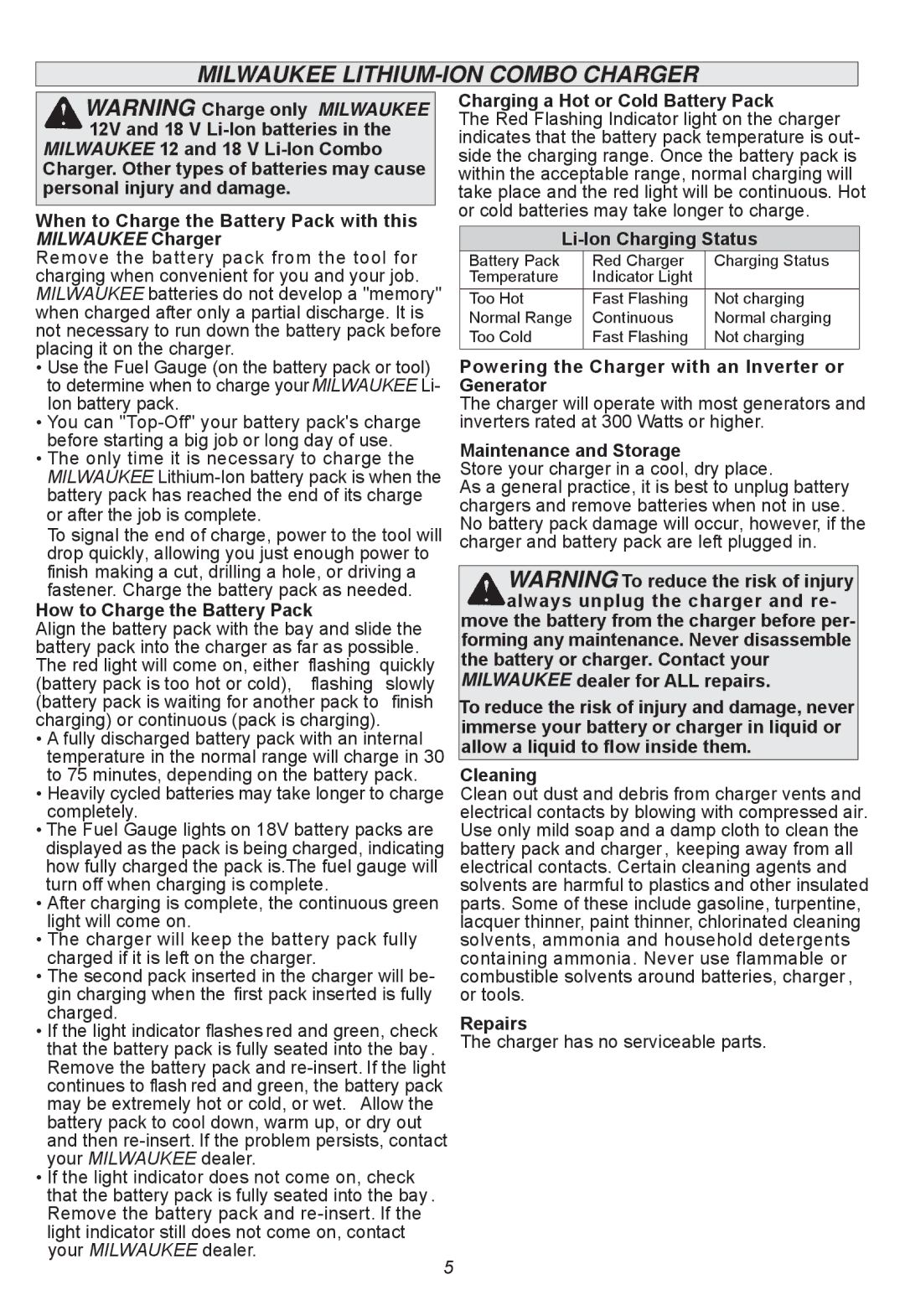
MILWAUKEE LITHIUM-ION COMBO CHARGER
WARNING Charge only MILWAUKEE 12V and 18 V
MILWAUKEE 12 and 18 V
When to Charge the Battery Pack with this MILWAUKEE Charger
Remove the battery pack from the tool for charging when convenient for you and your job. MILWAUKEE batteries do not develop a "memory" when charged after only a partial discharge. It is not necessary to run down the battery pack before placing it on the charger.
• Use the Fuel Gauge (on the battery pack or tool) to determine when to charge yourMILWAUKEE Li- Ion battery pack.
• You can
• The only time it is necessary to charge the MILWAUKEE
To signal the end of charge, power to the tool will drop quickly, allowing you just enough power to finish making a cut, drilling a hole, or driving a fastener. Charge the battery pack as needed.
How to Charge the Battery Pack
Align the battery pack with the bay and slide the battery pack into the charger as far as possible. The red light will come on, either flashing quickly (battery pack is too hot or cold), flashing slowly (battery pack is waiting for another pack to finish charging) or continuous (pack is charging).
• A fully discharged battery pack with an internal temperature in the normal range will charge in 30 to 75 minutes, depending on the battery pack.
• Heavily cycled batteries may take longer to charge completely.
• The Fuel Gauge lights on 18V battery packs are displayed as the pack is being charged, indicating how fully charged the pack is.The fuel gauge will turn off when charging is complete.
• After charging is complete, the continuous green light will come on.
• The charger will keep the battery pack fully charged if it is left on the charger.
• The second pack inserted in the charger will be- gin charging when the first pack inserted is fully charged.
• If the light indicator flashes red and green, check that the battery pack is fully seated into the bay . Remove the battery pack and
• If the light indicator does not come on, check that the battery pack is fully seated into the bay . Remove the battery pack and
5
Charging a Hot or Cold Battery Pack
The Red Flashing Indicator light on the charger indicates that the battery pack temperature is out- side the charging range. Once the battery pack is within the acceptable range, normal charging will take place and the red light will be continuous. Hot or cold batteries may take longer to charge.
Li-Ion Charging Status
Battery Pack | Red Charger | Charging Status |
Temperature | Indicator Light |
|
Too Hot | Fast Flashing | Not charging |
Normal Range | Continuous | Normal charging |
Too Cold | Fast Flashing | Not charging |
Powering the Charger with an Inverter or Generator
The charger will operate with most generators and inverters rated at 300 Watts or higher.
Maintenance and Storage
Store your charger in a cool, dry place.
As a general practice, it is best to unplug battery chargers and remove batteries when not in use. No battery pack damage will occur, however, if the charger and battery pack are left plugged in.
WARNING To reduce the risk of injury, always unplug the charger and re-
move the battery from the charger before per- forming any maintenance. Never disassemble the battery or charger. Contact your MILWAUKEE dealer for ALL repairs.
To reduce the risk of injury and damage, never immerse your battery or charger in liquid or allow a liquid to flow inside them.
Cleaning
Clean out dust and debris from charger vents and electrical contacts by blowing with compressed air. Use only mild soap and a damp cloth to clean the battery pack and charger, keeping away from all electrical contacts. Certain cleaning agents and solvents are harmful to plastics and other insulated parts. Some of these include gasoline, turpentine, lacquer thinner, paint thinner, chlorinated cleaning solvents, ammonia and household detergents containing ammonia. Never use flammable or combustible solvents around batteries, charger , or tools.
Repairs
The charger has no serviceable parts.
